THE NATURAL ENVIRONMENT
Geography 101
ToC
VALLEYS
Landslides
Patterns
Erode
Deposit
Hawai'i
Fluvial Landforms by Deposition
|
|
BOX 1 |
All of the sediment carried downstream must eventually be deposited. These deposits form deep layers of sedimentary material, have the effect of flattening out the landscape and build new low-lying land on the margins of oceans and lakes.
Floodplains
 As
noted in the previous section, floodplains form when
meandering rivers excavate broad flat-bottomed valleys. Repeated flood
cycles, depositing layer after layer of sediment, account for the flatness
of the floodplain. Sediment laid down by flooding rivers often produces
very fertile soil,
some of the most productive on Earth in fact. Great civilizations,
such as the Egyptians, Harappans, and Chinese, flourished on the floodplains
of
rivers
because
of the abundant, rich farmland.
As
noted in the previous section, floodplains form when
meandering rivers excavate broad flat-bottomed valleys. Repeated flood
cycles, depositing layer after layer of sediment, account for the flatness
of the floodplain. Sediment laid down by flooding rivers often produces
very fertile soil,
some of the most productive on Earth in fact. Great civilizations,
such as the Egyptians, Harappans, and Chinese, flourished on the floodplains
of
rivers
because
of the abundant, rich farmland.
The allure of farming this fertile soil is tempered by high risk, however. The very word, floodplain, makes it clear that flooding is inevitable. To minimize risk, humans have tried to control flooding in various ways. The oldest, and still most popular, method involves increasing the height of the natural levees that form along the riverbanks. Many countries have extensive levee systems that attempt to confine large rivers like the Mississippi in the American midwest. Perhaps nowhere has levee building reached such a high art as China's attempts to control the Huang He (Yellow River).
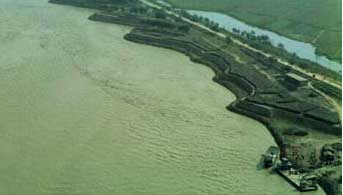 |
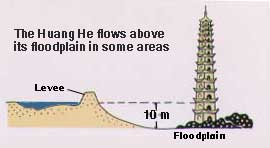 |
|
Huang He levee |
Huang He cross-section |
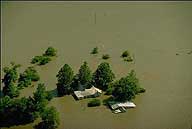 The
Huang He carries more sediment than any river on Earth and it disgorges
huge amounts of it into the Yellow Sea. Some of China's earliest civilizations flourished along the river's
lower reaches, fed by the
floodplain's
rich farmland.
But
repeated
epic
disasters
have
prompted 2000 years of levee building, mostly through the raw labor
of millions of Chinese.
Levee building has gone on for so long that the buildup of sediment
has elevated the river bed much as 10 meters (33 feet) above the surrounding floodplain.
Breeches of the levees have caused unimaginable human suffering, including
the deaths of millions.
The
Huang He carries more sediment than any river on Earth and it disgorges
huge amounts of it into the Yellow Sea. Some of China's earliest civilizations flourished along the river's
lower reaches, fed by the
floodplain's
rich farmland.
But
repeated
epic
disasters
have
prompted 2000 years of levee building, mostly through the raw labor
of millions of Chinese.
Levee building has gone on for so long that the buildup of sediment
has elevated the river bed much as 10 meters (33 feet) above the surrounding floodplain.
Breeches of the levees have caused unimaginable human suffering, including
the deaths of millions.
Despite the huge public works projects aimed at confining large rivers, their highest flood stages eventually overflow the levees, as repeated flooding of the Mississippi Valley reminds residents of the American Midwest.
 An
interesting landform created by successive floodplain building is an
alluvial, or stream, terrace. Alluvial terraces form when land slowly
rises by pressure from tectonic forces. Each time the land is raised,
a new floodplain forms.
A succession of these events can produce step-like
terrain, such as these stream terraces in New Zealand.
An
interesting landform created by successive floodplain building is an
alluvial, or stream, terrace. Alluvial terraces form when land slowly
rises by pressure from tectonic forces. Each time the land is raised,
a new floodplain forms.
A succession of these events can produce step-like
terrain, such as these stream terraces in New Zealand.
Deltas
When sediment-laden rivers empty into oceans or lakes at their mouth, the sediment may form a deposit called a delta. The term derives from the shape of the Nile delta, which looks like the Greek letter of the same name. Technically, this configuration is termed an arcuate delta, because the seaward end is shaped like an arc.
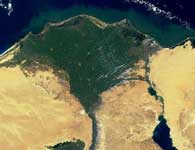 |
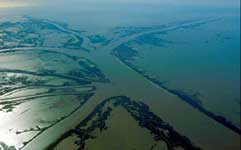 |
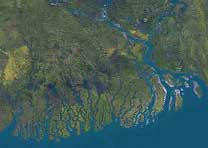 |
Nile delta
|
Mississippi delta
|
Ganges delta
|
The Mississippi River produces a different configuration called a bird's foot delta, in which long channels with natural levees splay out into the Gulf of Mexico. Much of the delta area itself is swampy or entirely under water. The Ganges and Brahmaputra Rivers, in South Asia, combine to form yet another type, a braided delta. Here, many islands exist and multiple channels incise the coastline. Like most deltas, the sediments create very rich farmland. This has attracted tens of millions of people, mostly Bangladeshi, to settle the area. Unfortunately, like floodplains, living off the fertile soil comes with risk. Hurricanes sweeping up the Bay of Bengal have created storm surge of more than 10 meters (33 feet) at times. This creates a severe hazard because half of Bangladesh's population lives at elevations less than 5 meters (16 feet) above sea level, many in the delta area itself.
Not all rivers form deltas. The Amazon, for example, with almost five times the water flow of any other river, is a good example. The area where it empties into the Atlantic deepens too quickly for sediment accumulation to form a true delta.